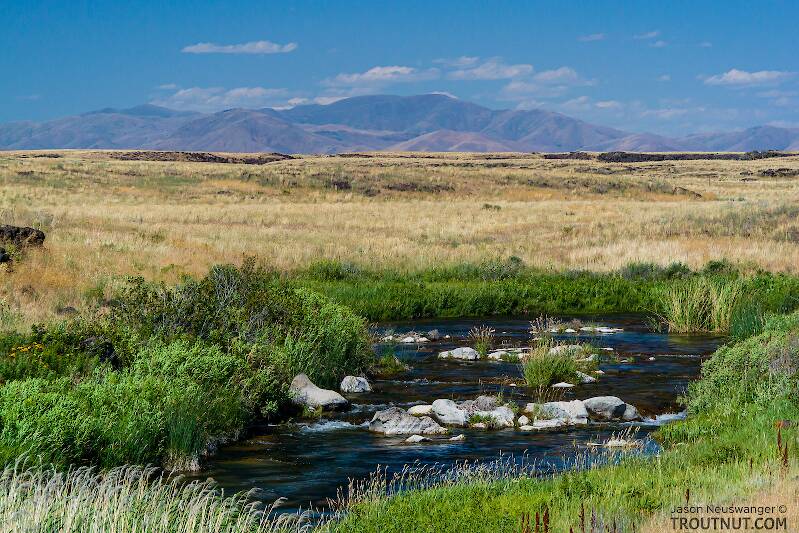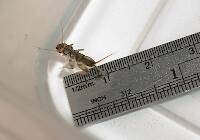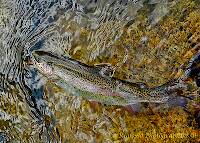
Hex Mayflies
Hexagenia limbata
The famous nocturnal Hex hatch of the Midwest (and a few other lucky locations) stirs to the surface mythically large brown trout that only touch streamers for the rest of the year.
Featured on the forum

This is the first of it's family I've seen, collected from a tiny, fishless stream in the Cascades. The three species of this genus all live in the Northwest and are predators that primarily eat stonefly nymphs Merritt R.W., Cummins, K.W., and Berg, M.B. (2019).

Troutnut is a project started in 2003 by salmonid ecologist Jason "Troutnut" Neuswanger to help anglers and
fly tyers unabashedly embrace the entomological side of the sport. Learn more about Troutnut or
support the project for an enhanced experience here.
Entoman on Feb 14, 2011February 14th, 2011, 8:40 am EST
Hey Guys,
I'm in the market for a new camera to take pictures of the little stuff fish like to eat. While I want it to be capable of photos worth posting, it needs to be small and P & S since I will be taking pictures while fishing, not the other way around. Realistically that means off hand shooting - no tripods, excessive fooling around with settings & lenses, special lighting, staging etc. Any advice?
Kurt
I'm in the market for a new camera to take pictures of the little stuff fish like to eat. While I want it to be capable of photos worth posting, it needs to be small and P & S since I will be taking pictures while fishing, not the other way around. Realistically that means off hand shooting - no tripods, excessive fooling around with settings & lenses, special lighting, staging etc. Any advice?
Kurt
"It's not that I find fishing so important, it's just that I find all other endeavors of Man equally unimportant... And not nearly as much fun!" Robert Traver, Anatomy of a Fisherman
Troutnut on Feb 14, 2011February 14th, 2011, 8:57 am EST
Do you care if it's waterproof, water-resistant, or neither? Being able to shoot underwater photos of fish food in its natural habitat is pretty cool.
You have to give up a little bit of image quality to get one of the waterproof point-and-shoots, but it may be worth it. For waterproof cameras, I'd look at the Canon Powershot D10 (my current waterproof camera), the Panasonic Lumix DMC-TS2. The Canon D10 has been reviewed as having the best image quality of the bunch, though it's still not as good as many non-waterproof cameras. It's a little bigger than some, but still easily pocketable in a decent-sized pocket.
If you don't care about being waterproof, there's no end to your choices. Check out http://www.dpreview.com/... it's my favorite site for in-depth camera reviews, buying comparisons, etc. I'd look into Canon, Nikon, and Panasonic Lumix cameras first, but plenty of other manufacturers make good ones.
You have to give up a little bit of image quality to get one of the waterproof point-and-shoots, but it may be worth it. For waterproof cameras, I'd look at the Canon Powershot D10 (my current waterproof camera), the Panasonic Lumix DMC-TS2. The Canon D10 has been reviewed as having the best image quality of the bunch, though it's still not as good as many non-waterproof cameras. It's a little bigger than some, but still easily pocketable in a decent-sized pocket.
If you don't care about being waterproof, there's no end to your choices. Check out http://www.dpreview.com/... it's my favorite site for in-depth camera reviews, buying comparisons, etc. I'd look into Canon, Nikon, and Panasonic Lumix cameras first, but plenty of other manufacturers make good ones.
Jason Neuswanger, Ph.D.
Troutnut and salmonid ecologist
Troutnut and salmonid ecologist
Entoman on Feb 14, 2011February 14th, 2011, 9:40 am EST
Hi Jason,
Thanks for answering. Ah! Waterproof/bullet proof would be right up my alley! I thought I was gonna have to keep it in a zip-lock! I still try to wade very aggressive like when I was in my thirties (only slower). Because of that, I get wet a little (OK, a lot) more than I used to. Didn't know they worked for macro. Do you just get as close as you can and crop later? I'd also like to use it at home for taking pictures that will be useful for ID purposes, but that is probably asking for too much out of one camera?
Kurt
Thanks for answering. Ah! Waterproof/bullet proof would be right up my alley! I thought I was gonna have to keep it in a zip-lock! I still try to wade very aggressive like when I was in my thirties (only slower). Because of that, I get wet a little (OK, a lot) more than I used to. Didn't know they worked for macro. Do you just get as close as you can and crop later? I'd also like to use it at home for taking pictures that will be useful for ID purposes, but that is probably asking for too much out of one camera?
Kurt
"It's not that I find fishing so important, it's just that I find all other endeavors of Man equally unimportant... And not nearly as much fun!" Robert Traver, Anatomy of a Fisherman
PaulRoberts on Feb 14, 2011February 14th, 2011, 9:57 am EST
I have the Oly 1030SW. It's waterproof to 30ft, drop-proof to 6ft, and has a pretty wide lens -very helpful when shooting yourself. I fish form a float tube a lot and the wide lens is important.
It's no bigger than most point-n-shoots. Because of that, it has a small lens so it's not at its best in low natural light, like the camera's Jason recommends. Super Macro mode will focus down to something like 2inches (!). In that mode there is a small LED that comes on and illuminates tiny objects well. The images in my posts are all from this camera. Most are in the Fishing Reports section.
The new version is 14mp. Mine's 10. About $375.
It's no bigger than most point-n-shoots. Because of that, it has a small lens so it's not at its best in low natural light, like the camera's Jason recommends. Super Macro mode will focus down to something like 2inches (!). In that mode there is a small LED that comes on and illuminates tiny objects well. The images in my posts are all from this camera. Most are in the Fishing Reports section.
The new version is 14mp. Mine's 10. About $375.
Troutnut on Feb 14, 2011February 14th, 2011, 10:08 am EST
You'll have no problem taking pictures useful for identification with a waterproof camera. They should all have macro modes. You're not asking too much out of one camera. You'll probably be very happy with the quality of one of the waterproof cameras.
You don't necessarily always get as close as you can to the subject. It depends what you want to show, what the lighting's like, etc. I'm sure you can find some good articles online about how to take best advantage of the macro mode in point & shoot digital cameras.
Finally, I wouldn't totally dismiss having a tripod. The smallest size of Joby GorillaPod fits easily in a pocket and can be set up on the ground or wrapped around branches and stuff, and it can make the difference between a spectacular shot and an unusable blurry one in some low-light situations.
You don't necessarily always get as close as you can to the subject. It depends what you want to show, what the lighting's like, etc. I'm sure you can find some good articles online about how to take best advantage of the macro mode in point & shoot digital cameras.
Finally, I wouldn't totally dismiss having a tripod. The smallest size of Joby GorillaPod fits easily in a pocket and can be set up on the ground or wrapped around branches and stuff, and it can make the difference between a spectacular shot and an unusable blurry one in some low-light situations.
Jason Neuswanger, Ph.D.
Troutnut and salmonid ecologist
Troutnut and salmonid ecologist
Entoman on Feb 14, 2011February 14th, 2011, 2:40 pm EST
Jason & Paul,
Thanks big time for the advice! Gonna check out the three you guys recommended and make my choice. BTW Jason, that gorilla pod thing is amazing! I can see hooking it to the gunwale of my boat for the caddis and mayflies that always seem to pose there.
I was leaning towards the Canon S95 w/ some cool after market accessories that would have set me back 600 smackers before I was done - customized grips (to better hang on to the damned little thing with my bear paws), adapter kit, macro lens, polarized filter, ring light, and other gizmos. Just so I could drop the whole shebang in the creek? I don't know that keeping the thing sealed in a zip lock near water in humid or rainy conditions was such a good idea anyway. Any water droplets inside would convert to vapor from my body heat - and that can't be good... And when I'm fishing? I never would've farted around with all that stuff anyway (and I don't know that the bugs would hold still long enough as I fumbled around either). Maybe blow cigar smoke on 'em like beekeepers do?
Going online to figure it all out was driving me crazy! ISO's, focal distance, depth of field, f/stop ratios, ring lighting, image processors,megapixel sensors... Uggg.... Let me get back to my bug books!!! The choices are bewildering to say the least. You've made things much simpler for me.
Thanks again,
Kurt
Thanks big time for the advice! Gonna check out the three you guys recommended and make my choice. BTW Jason, that gorilla pod thing is amazing! I can see hooking it to the gunwale of my boat for the caddis and mayflies that always seem to pose there.
I was leaning towards the Canon S95 w/ some cool after market accessories that would have set me back 600 smackers before I was done - customized grips (to better hang on to the damned little thing with my bear paws), adapter kit, macro lens, polarized filter, ring light, and other gizmos. Just so I could drop the whole shebang in the creek? I don't know that keeping the thing sealed in a zip lock near water in humid or rainy conditions was such a good idea anyway. Any water droplets inside would convert to vapor from my body heat - and that can't be good... And when I'm fishing? I never would've farted around with all that stuff anyway (and I don't know that the bugs would hold still long enough as I fumbled around either). Maybe blow cigar smoke on 'em like beekeepers do?
Going online to figure it all out was driving me crazy! ISO's, focal distance, depth of field, f/stop ratios, ring lighting, image processors,megapixel sensors... Uggg.... Let me get back to my bug books!!! The choices are bewildering to say the least. You've made things much simpler for me.
Thanks again,
Kurt
"It's not that I find fishing so important, it's just that I find all other endeavors of Man equally unimportant... And not nearly as much fun!" Robert Traver, Anatomy of a Fisherman
Troutnut on Feb 14, 2011February 14th, 2011, 3:42 pm EST
Going online to figure it all out was driving me crazy! ISO's, focal distance, depth of field, f/stop ratios, ring lighting, image processors,megapixel sensors... Uggg.... Let me get back to my bug books!!! The choices are bewildering to say the least. You've made things much simpler for me.
There are a lot of confusing statistics.
The one downside to getting one of the waterproof cameras is that, as far as I know, they don't accept a polarizing filter, and those are pretty nice to have on the stream for scenery shots. Ring lights are pretty high tech specialized macro photography gear, and would be quite a pain to carry around on the stream. You do pay a little bit in terms of these advanced features for the convenience and peace-of-mind of a waterproof camera, but I think it's well worth it.
Anyway, to help clear up some of that other confusion about f/stop etc, I'll give my thoughts on what to look for in a camera review:
- Good image quality, e.g. sharpness and color.
- Good low-light performance (meaning low noise). This is where camera differences often seem to show up the most, and poor ones are either noisy/grainy or blurry or both in lighting conditions where the good ones still take nice pictures.
- Optical image stabilization. Really helps with low-light performance.
- Smart control layout. Easy to turn macro mode on and off without having to fumble through an annoying menu, etc.
- Easy to take with you and quickly access without worrying about damaging it. You can't take a good picture when the opportunity presents itself if you left your camera home or have to fish it out of a zip-loc bag or something.
- Field-of-view. This is about the same for many cameras, but some can shoot at a wider angle that improves some shots.
- Performance of macro mode... I'm not sure what all influences this in a compact digicam anymore, but a good review should assess it.
Again I cannot recommend dpreview.com highly enough for camera reviews; they're great. Photo.net and luminous-landscape.com are also excellent, but don't review all the cameras that come out, so you might not find relevant information there.
What not to look for:
- Megapixels! All the modern cameras have so many that the difference doesn't really matter. Sometimes the cameras with fewer pixels also have larger pixels, which are less susceptible to noise in low-light situations. The race to obscenely high MP counts is a pointless marketing trick. High MP images also take up all that much more hard drive space. 10-12MP is all you really need; most of the best images on this site were shot at 8MP. There are good cameras with high numbers, but you don't need them unless you're planning on making lots of poster-sized prints of your photos.
- Optical zoom power. Some people will want long zooms on a point & shoot, but often they'll just lead to blurry images from camera shake if you're not using a tripod. And they have to trade off some lens quality to get the long zoom. I'm rarely unhappy walking around with just 3X zoom, there are times when I wish I could go out to maybe 7X, but when you get up to like 15X or 20X that's very rarely useful.
- Digital zoom. Digital zoom is a complete scam, just a silly low-quality on-camera way of accomplishing what you could do by blowing up the image on your computer later anyway.
- Also, don't worry about f/stop, ISO, focal length, and similar metrics for point & shoot cameras. They affect the things that matter, but you can read about the things that matter in reviews more directly without understanding those technical details.
Also, I'm not sure what you meant by "image processors." Each camera has an internal processing chip, but mostly those won't matter to you. If you were talking about image processing software, that can matter a lot! Learning how to use it well is important, too. You can save a bad image, or make a good image spectacular. Adobe Lightoom 3 is the king of all image processing software in my opinion and I'd highly recommend it, but it's kind of pricey. It's only worth the money if you're committed to spending some time exploring its capabilities and not just using the default settings for everything. That doesn't take a long time, and you pick it up gradually as you play with your pictures, but you do have to sort of enjoy that kind of thing. If you don't like digital tinkering, it'll be a waste of $$$.
Jason Neuswanger, Ph.D.
Troutnut and salmonid ecologist
Troutnut and salmonid ecologist
Entoman on Feb 14, 2011February 14th, 2011, 5:12 pm EST
Hey Jason,
Something about the size of the image processor being important because that is the digital equivalent of the film plate? My understanding is a small processor gets filled up with the image or true 1/1 easier which means greater depth of focus. Supposedly an irony is in play because that means the compact P & S's (with their smaller processors) can give greater field of depth in macro than the full sized DSLR's without a lot of gadgets. That's why parts of the bug a little closer or further away from the center are still in focus? In other words, I have no idea!:) Check out the canon s95 and the rationale behind its features (like "going back" to 10mpixels) They seem to align with the features you mentioned as most important. I'm waffling... Let me know what you think.
Kurt
Kurt
Also, I'm not sure what you meant by "image processors."
Kurt
Kurt
"It's not that I find fishing so important, it's just that I find all other endeavors of Man equally unimportant... And not nearly as much fun!" Robert Traver, Anatomy of a Fisherman
Entoman on Feb 14, 2011February 14th, 2011, 6:35 pm EST
PS
The ring light and macro lens were for back home where I could stage at my leisure.
Kurt
The ring light and macro lens were for back home where I could stage at my leisure.
Kurt
"It's not that I find fishing so important, it's just that I find all other endeavors of Man equally unimportant... And not nearly as much fun!" Robert Traver, Anatomy of a Fisherman
Troutnut on Feb 14, 2011February 14th, 2011, 8:10 pm EST
Something about the size of the image processor being important because that is the digital equivalent of the film plate?
I think you're thinking of the sensor.
Check out the canon s95 and the rationale behind its features (like "going back" to 10mpixels) They seem to align with the features you mentioned as most important.
I just checked out dpreview's comparison of the s95 with the Panosonic Lumix LX5, which is a minor upgrade to the Lumix LX3, which I own. My LX3 is my really serious point & shoot, and my Canon D10 is my might-get-wet point & shoot. When I'm carrying the LX3 around, I'm always thinking about being careful with it, where I put it, not getting it wet, etc. The D10 is ideal for underwater pictures, or taking pictures of splashing fish, and running around with it in my vest pocket all day without worrying about rain, falling in, etc.
In the review, the s95 compared favorably with the LX5, and those two may very well be the best compact digital cameras on the market. So it's an excellent camera, no doubt. The question is: do you need the best camera? Or the best fishing camera? You can buy one that takes state-of-the-art top-notch pictures and shouldn't get wet, or one that takes fairly average pictures but can withstand all sorts of abuse. How you make that trade-off is up to you. I can tell you that having a no-worry camera with you on the river is an awfully nice feeling that shouldn't be underestimated, but I do love the images I get out of my LX3, too, and my D10 can't quite compare.
Jason Neuswanger, Ph.D.
Troutnut and salmonid ecologist
Troutnut and salmonid ecologist
PaulRoberts on Feb 15, 2011February 15th, 2011, 4:05 am EST
Great stuff from Jason of course.
Just to ease your mind: Cameras are amazing now; Good exposures are pretty easy to get, and digital touching up is easy. It also depends on your purposes -where you'll be "publishing". It used to be we published for print magazines with film and required pretty high quality gear and perfect exposure. But if you are "publishing" for the screen, or for say PPT presentations, point-n-shoots cover a lot of ground. I'm not up on digital requirements for print now. It's been a while.
I have two outfits: A compact for the field and an SLR for home. For the home setup I use either photo lights or a small TTL dedicated flash on a cord. The problem with the photo lights is that they are too hot and just cook your coldwater bugs. The TTL flash produces amazingly accurate exposures on small objects, like bugs -esp submerged bugs. Ring lights are a problem when shooting things in water bc the light is at the wrong angle to the water surface, and you get a big nasty reflection. If you illuminate from an angle, via a corded flash, or even through the side of a taller dish, you can get great non-reflective lighting.
Good point-n-shoots also expose really well. It's almost a no brainer anymore. And lens quality, across the major makers, is at a level not seen in the now-distant past. For a basic fishing camera my Olympus 1030sw has been just great. It's only drawback is lens size, but... then again, it's a compact pocket sized camera.
Jason's list of priorities is spot on. I would add, for a fishing camera: portability and waterproof. But for magazine publishing, I'd highlight lens quality and size.
Just some thoughts.
Just to ease your mind: Cameras are amazing now; Good exposures are pretty easy to get, and digital touching up is easy. It also depends on your purposes -where you'll be "publishing". It used to be we published for print magazines with film and required pretty high quality gear and perfect exposure. But if you are "publishing" for the screen, or for say PPT presentations, point-n-shoots cover a lot of ground. I'm not up on digital requirements for print now. It's been a while.
I have two outfits: A compact for the field and an SLR for home. For the home setup I use either photo lights or a small TTL dedicated flash on a cord. The problem with the photo lights is that they are too hot and just cook your coldwater bugs. The TTL flash produces amazingly accurate exposures on small objects, like bugs -esp submerged bugs. Ring lights are a problem when shooting things in water bc the light is at the wrong angle to the water surface, and you get a big nasty reflection. If you illuminate from an angle, via a corded flash, or even through the side of a taller dish, you can get great non-reflective lighting.
Good point-n-shoots also expose really well. It's almost a no brainer anymore. And lens quality, across the major makers, is at a level not seen in the now-distant past. For a basic fishing camera my Olympus 1030sw has been just great. It's only drawback is lens size, but... then again, it's a compact pocket sized camera.
Jason's list of priorities is spot on. I would add, for a fishing camera: portability and waterproof. But for magazine publishing, I'd highlight lens quality and size.
Just some thoughts.
Entoman on Feb 15, 2011February 15th, 2011, 4:38 am EST
Thanks guys,
My goal is to just take pictures of bugs and such that will be useful for sharing with you guys. Publishing? Don't have the time, inclination, or talent to worry much about that. I want to fish and take the occasional picture, not the other way around.
Kurt
My goal is to just take pictures of bugs and such that will be useful for sharing with you guys. Publishing? Don't have the time, inclination, or talent to worry much about that. I want to fish and take the occasional picture, not the other way around.
Kurt
"It's not that I find fishing so important, it's just that I find all other endeavors of Man equally unimportant... And not nearly as much fun!" Robert Traver, Anatomy of a Fisherman
Troutnut on Feb 15, 2011February 15th, 2011, 5:43 am EST
Ring lights are a problem when shooting things in water bc the light is at the wrong angle to the water surface, and you get a big nasty reflection.
Useful tip I didn't know! I'd never tried a ring light. I use a TTL flash with twin heads mounted on the tip of the lens, with polarizing film over them and a polarizing filter on the lens to reduce glare on the subject.
My goal is to just take pictures of bugs and such that will be useful for sharing with you guys. Publishing? Don't have the time, inclination, or talent to worry much about that. I want to fish and take the occasional picture, not the other way around.
Then I would definitely suggest one of the waterproof cameras, not the s95. The quality of any of the good waterproofs will be more than good enough for posting stuff here, and the other advantages (no worries on the stream, underwater pictures) are very significant.
Jason Neuswanger, Ph.D.
Troutnut and salmonid ecologist
Troutnut and salmonid ecologist
Entoman on Feb 15, 2011February 15th, 2011, 5:58 am EST
Jason - Well, it's been a circuitous route, but that's the conclusion I've come to as well. The only regret I have is not coming to the forum with this BEFORE I confused myself surfing all over the place.
Thanks again,
Kurt
Thanks again,
Kurt
"It's not that I find fishing so important, it's just that I find all other endeavors of Man equally unimportant... And not nearly as much fun!" Robert Traver, Anatomy of a Fisherman
Quick Reply
Related Discussions
Topic
Replies
Last Reply
4
Mar 16, 2010
by Wiflyfisher
by Wiflyfisher
3
Nov 25, 2006
by Troutnut
by Troutnut










